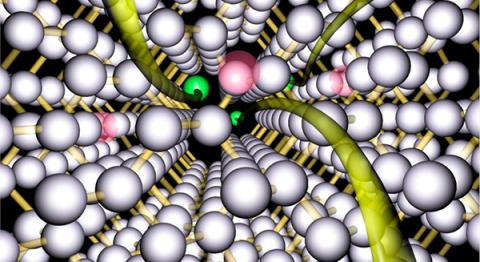Researchers investigate how boron-doped diamonds reach a state of "superconductivity"
A collaboration with the participation of the Material Sciences Institute of Madrid (ICMM), CSIC, has studied the behavior of diamonds irradiated with boron ions and their possible applications.

Diamond is a material of great technological and scientific interest due to its excellent physical, chemical, and structural properties. Among others, diamond crystal is the hardest natural solid, retains its solid properties at extremely high temperatures, and combines excellent electrical insulation with the highest known thermal conductivity.
More recently, it was discovered that boron-doped diamond can exhibit superconductivity at low temperatures, although the details of the phenomenon are not fully understood.
Now, researchers from the Center for Material Microanalysis (CMAM) at the Autonomous University of Madrid (UAM) and the Materials Science Institute of Madrid (ICMM), CSIC, have studied the effects of boron ion irradiation on diamonds and their thermal recovery, with the aim of exploring the possibility of obtaining superconducting structures.
The study, published in the journal Carbon, analyzes the severe damage inflicted on diamond crystals when irradiated with ions accelerated to energies of 9 million electron volts (MeV), and their subsequent recovery by heating the diamonds to 1000 °C.
The researchers used high-purity diamond crystals, irradiating them with boron ions in the CMAM accelerator. Subsequently, they studied the microscopic consequences using local microscale Raman spectroscopy maps at the ICMM.
Although superconductivity was not achieved in the boron-doped diamond samples in this study, the findings provide valuable information about the behavior of diamond irradiated with boron ions and their potential applications in materials science.
Future research in this field could open up new avenues for the development of advanced materials and electronic devices with unique properties and innovative applications.
Ion accelerator and micro-Raman maps
CMAM has one of the two ion accelerator centers in Spain. The researchers used the accelerator to create boron-implanted diamond microstructures, selectively directing a microbeam of boron ions with sufficient energy to penetrate the diamond sample. They then studied these irradiated areas using two-dimensional maps of Raman spectroscopy and photoluminescence at the ICMM.
Thus, they found that as boron fluence increases, carbon migrates to interstitial sites outside the implantation path, and the fraction of amorphous carbon increases within the irradiation path. For low fluences, annealing at 1000 °C is capable of fully recovering the diamond structure without graphitization, while for higher fluences, recovery is significant but some disorder remains. For high fluences, annealing at 1200 °C is detrimental to the diamond lattice, and traces of graphitization appear.
The researchers measured the electrical resistance of a selection of the most representative irradiations in the Low-Temperature Laboratory at UAM. In no case did they observe the superconducting transition, at least when cooled to 2 Kelvin. However, the samples treated at 1000 °C showed a clear improvement in their electrical conductivity, but this worsened by orders of magnitude after subsequent annealing at 1200 °C.
The research concludes that incomplete healing of the diamond's crystalline lattice and the interstitial location of boron could explain why optimally doped samples do not exhibit superconductivity.
-- UAM Press Office --
Reference:
Jiménez-Riobóo, R. J., Gordillo, N., de Andrés, A., Redondo-Cubero, A., Moratalla, M., Ramos, M. A., Ynsa, M. D. 2023. Boron-doped diamond by 9 MeV microbeam implantation: Damage and recovery. Carbon 208: 421−431. doi: 10.1016/j.carbon.2023.04.004
Instituto de Ciencia de Materiales de Madrid (ICMM)
Sor Juana Ines de la Cruz, 3
Cantoblanco, 28049
Madrid, España
Telephone: (+34) 91 334 90 00
Email: @email
Communication Office: @email

Acknowledge the Severo Ochoa Centres of Excellence program through Grant CEX2024-001445-S/ financiado por MICIU/AEI / 10.13039/501100011033

Contacto | Accesibilidad | Aviso legal | Política de Cookies | Protección de datos